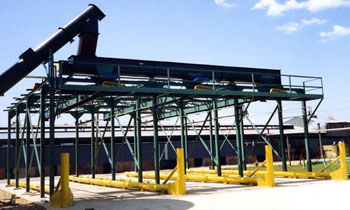Material Load Out Systems

Material Load Out Systems
After waste materials are collected and transferred, various methods are used to load the waste into containers, trailers, boilers, storage bins, silos or to another manufacturing process. In low pressure air systems, rotary airlocks are used to drop material out of cyclones and filters. If many drop points are needed, screw conveyors can be added with motorized slide gates to distribute the waste. Design parameters similar to the ones used in conveying systems are also used in the engineering of Load-Out Systems. By determining the material characteristics, bulk density (lbs./ cub.ft.), volume capacity (lbs./hour), and desired feed rate.
Types of Waste Transfer Systems
Material Load Out Sytems - Screw ConveyorsScrew Conveyors
A widely used, cost-effective method to load-out waste into containers, hoppers, bins, silos, and trailers is with the use of screw conveyors. They are used to feed boilers and other equipment where a metered feed system is needed. Screws and augers are also incorporated into equipment specifically designed to unload silos and storage bins. Incline screw conveyors can then elevate the material to a point over an open-top trailer or other container. When the material is discharged into a trailer, a leveling screw can be added to distribute the waste evenly.
Material Load Out Sytems - Screw ConveyorsTrailer Blow-In Systems
A less expensive way to directly load waste material into a trailer is with the use of a low pressure blower system. A van trailer is parked and sealed at a “back-stop” where a positive pressure pipe blows waste into the trailer. A negative pressure pipe exits the trailer and travels back to the blower creating a close-loop. If any material does not settle in the trailer, it exits and loops back around.